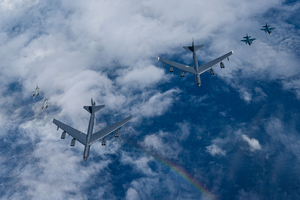Certainly. Here’s a professionally rephrased version of the original summary, suitable for journalistic publication:
—
**Joint Air Drill Highlights Trilateral Military Cooperation Amid North Korean Threats**
On Friday, July 11, 2025, South Korea, the United States, and Japan carried out a major joint air exercise in international airspace near Jeju Island. This drill marked a significant step in strengthening their trilateral defense posture and deterrence capability in response to North Korea’s escalating nuclear and missile activities.
According to South Korea’s Ministry of National Defense, the exercise featured a U.S. B-52H strategic bomber—its first deployment to the Korean Peninsula this year—alongside South Korea’s KF-16 fighters and Japan’s F-2 jets. The involvement of the nuclear-capable B-52H underscored Washington’s extended deterrence commitments and its readiness to protect allies in the region against potential nuclear threats.
More than a show of force, the joint drill symbolized growing military alignment among the three countries. It aimed to boost their coordinated response capabilities and send a firm message to Pyongyang and other adversaries about the strength and unity of the U.S.-South Korea-Japan alliance.
The air exercise took place in conjunction with a high-level meeting of senior military officials from the three nations in Seoul. Admiral Kim Myung-soo of South Korea, General Dan Caine of the United States, and General Yoshihide Yoshida of Japan convened to assess the security landscape, review North Korea’s military buildup, and explore avenues to further enhance trilateral defense cooperation. The three military leaders reaffirmed their joint commitment to regional peace and stability, particularly in the Indo-Pacific.
General Caine—the Chairman of the U.S. Joint Chiefs of Staff—highlighted heightened concerns over North Korea’s growing military collaboration with Russia and China. Warning of unprecedented developments in Pyongyang’s weapons programs, he emphasized the necessity of a united front and shared defense responsibilities among allies. This visit marked General Caine’s first official trip to South Korea as top U.S. military officer and coincided with the first time Seoul hosted a trilateral chiefs of defense meeting.
The three partners also announced plans to broaden the scope of their Freedom Edge exercises, which aim to test multi-domain cooperation—spanning air, land, sea, and cyberspace—and improve interoperability in addressing a range of security threats.
North Korea swiftly criticized the drills via a statement published by its state-run Korean Central News Agency (KCNA). Citing the exercise as provocative, its defense ministry accused the three countries of forming a “nuclear-based triangular military alliance” and threatened countermeasures in retaliation to what it perceived as an infringement on its sovereignty. Historically, Pyongyang has denounced allied military exercises as rehearsals for invasion and a threat to its regime.
In response, South Korea’s Defense Ministry reaffirmed the defensive nature of the joint drills, stating that the maneuvers aim primarily to secure national and regional safety against continued threats from the North. The ministry added that the three nations would continue conducting such combined exercises to maintain readiness and prevent potential escalation, even as North Korea’s military provocations persist.
The July 11 drill and associated diplomatic engagements underscored the deepening tri-nation cooperation as security dynamics in the region shift amid rising military tensions. As the U.S., South Korea, and Japan shore up their coordination, they face the challenge of deterring aggression while promoting a stable balance of power across Northeast Asia.
Together, the joint air drill and the historic defense summit signaled a unified stance against North Korean provocations, with the presence of the B-52H serving as a powerful symbol of enduring U.S. commitment to regional allies. Yet, with continued North Korean weapons advancements and closer alignment with Russia and China, the regional trajectory remains uncertain, and military preparedness among allies more crucial than ever.
—
Let me know if you would like the Vietnamese translation of this rewritten summary.


